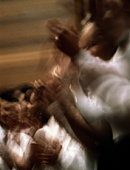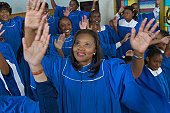
Important Chords And Progressions in Gospel Piano
You may have noticed that Gospel music is reminiscent of Jazz or Blues in its style and sounds, however, it is still distinguishably different. Gospel music, unlike Jazz or Blues, is actually intended for a capella voices. Gospel music is the background to the singing, not the accompaniment. Gospel music also must be versatile to the needs of the congregation. If the mood of worship is solemn and sad, the sounds of the chords you are playing must reflect that mood and enhance it. If the Voices of the congregation are lively and uplifted in prayer and praise, you must be able to reflect those voices as well. Gospel chordal movements can be played in numerous variations as needed depending on the circumstances. During a sermon, Gospel chordal movements can be used to enhance the words of the preacher. Think of the chords as the exclamation point to a sentence. It emphasizes the mood and the words. You must learn to play chordal movements to reflect those moods, as they can change often in the course of a sermon. If you listen closely to Gospel music you will find that it is played in 3/4th time. This makes it very easy to distinguish from other forms of music. Gospel music is also full of musical slurs. A musical slur is when one note or chord slides smoothly into the next not or chord without a break in the music.
When playing Gospel music, your left hand on the piano is the bass and your right hand plays the Gospel chordal movements. The most important thing to learn in Gospel chordal movements is the thirteenth chords on the right hand. This sounds scarier than it actually is. When playing Gospel piano, one of the most distinguishing parts of the music is the chordal movements. Chordal movements are accomplished by playing the chord of thirteen, which is based on seven notes, the 1-3-5-7b-9-11-and 13 keys. Now, obviously it is impossible to play seven keys with one hand and although this is a beautiful chord, it is definitely abbreviated for Gospel chordal movements. To play the Gospel chordal thirteenth movement, it is easier to play the first not on the left hand and then skip the second and third notes, while playing the fourth, fifth, sixth and seventh notes on the right hand. These are to be played simultaneously. In other words, if you are playing the C major chord in the thirteenth, you will use the notes C-E-G-Bb-D-F-and A. The actual playing of the thirteenth will look more like C-Bb-D-F-and A simultaneously. It is easiest to play the beginning key on the left hand. Playing a variety of the thirteenth chords alongside the left handed bass will be the first step in learning to play chordal movements in Gospel worship music.
http://pianoplayerworld.com/MikeBerealMasterClass.html
| ||||
|
Although every attempt has been made to make information as accurate as possible, we are not responsible for any errors that may appear.
 If you are interested in learning to
If you are interested in learning to 
 This is accomplished by the way you play your fingers on the piano and not so much
by way of the foot pedals. Slurs in chordal movements are important to keep the music together and flowing in
order to keep the mood of worship without pauses or breaks.
This is accomplished by the way you play your fingers on the piano and not so much
by way of the foot pedals. Slurs in chordal movements are important to keep the music together and flowing in
order to keep the mood of worship without pauses or breaks.



